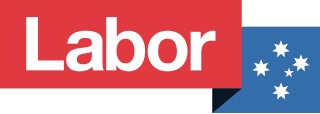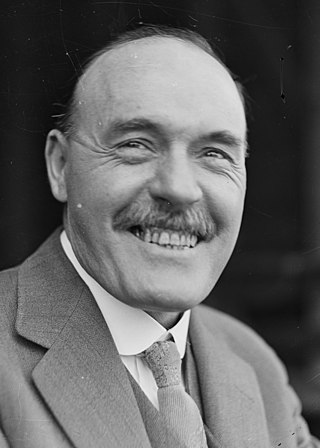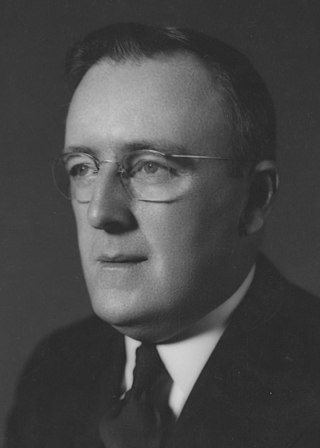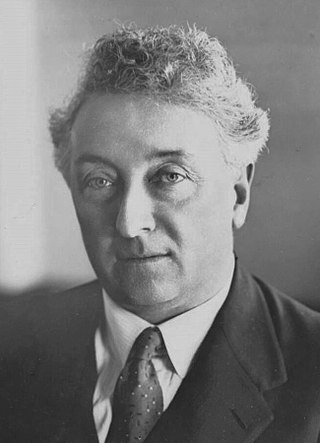
The Australian Labor Party (ALP), also commonly known as the Labor Party or simply Labor, is the major centre-left political party in Australia and one of two major parties in Australian politics, along with the centre-right Liberal Party of Australia. The party has been in government since being elected at the 2022 federal election, and with political branches in each state and territory, they currently form government in New South Wales, Queensland, South Australia, Victoria, Western Australia, the Australian Capital Territory, and the Northern Territory. As of 2023, Tasmania is the only state or territory where Labor forms the opposition. It is the oldest continuous political party in Australian history, being established on 8 May 1901 at Parliament House, Melbourne, the meeting place of the first federal Parliament.

The United Australia Party (UAP) was an Australian political party that was founded in 1931 and dissolved in 1945. The party won four federal elections in that time, usually governing in coalition with the Country Party. It provided two prime ministers: Joseph Lyons (1932–1939) and Robert Menzies (1939–1941).

John Thomas Lang, usually referred to as J. T. Lang during his career and familiarly known as "Jack" and nicknamed "The Big Fella", was an Australian politician, mainly for the New South Wales Branch of the Labor Party. He twice served as the 23rd Premier of New South Wales from 1925 to 1927 and again from 1930 to 1932. He was dismissed by the Governor of New South Wales, Sir Philip Game, at the climax of the 1932 constitutional crisis and resoundingly lost the resulting election and subsequent elections as Leader of the Opposition. He later formed Lang Labor that contested federal and state elections and was briefly a member of the Australian House of Representatives.

The Democratic Labor Party (DLP) was an Australian political party. The party came into existence following the 1955 ALP split as the Australian Labor Party (Anti-Communist), and was renamed the Democratic Labor Party in 1957. In 1962, the Queensland Labor Party, a breakaway party of the Queensland branch of the Australian Labor Party, became the Queensland branch of the DLP.

Edward John Ward was an Australian politician who represented the Australian Labor Party (ALP) in federal parliament for over 30 years. He was the member for East Sydney for all but six and a half weeks from 1931 until his death in 1963. He served as a minister in the Curtin and Chifley governments from 1941 to 1949, and was also known for his role in the ALP split of 1931.

John Smith "Jock" Garden was an Australian clergyman, trade unionist and politician. He was one of the founders of the Communist Party of Australia.

Lang Labor was a faction of the Australian Labor Party (ALP) consisting of the supporters of Jack Lang, who served two terms as Premier of New South Wales and was the party's state leader from 1923 to 1939. It controlled the New South Wales branch of the ALP throughout most of the 1920s and 1930s. The faction broke away to form separate parliamentary parties on several occasions and stood competing candidates against the ALP in state and federal elections.

John Albert Beasley was an Australian politician who was a member of the House of Representatives from 1928 to 1946. He served in the Australian War Cabinet from 1941 to 1946, and was a government minister in the Curtin and Chifley governments. Beasley was a member of the Australian Labor Party, although on two occasions he left the party to join the breakaway Lang Labor groups, leading the faction in federal parliament. He concluded his career as High Commissioner to the United Kingdom from 1946 until his death in 1949.
The State Labor Party, also known as State Labor Party (Hughes-Evans), was an Australian political party which operated exclusively in the state of New South Wales (NSW) in the early 1940s. The party was initially a far-left faction of the Australian Labor Party, strongly opposed to the right-wing faction of the party dominated by Jack Lang, the NSW Premier between 1925 and 1927, and again between 1930 and 1932.

The 1937 Australian federal election was held in Australia on 23 October 1937. All 74 seats in the House of Representatives, and 19 of the 36 seats in the Senate were up for election. The incumbent UAP–Country coalition government, led by Prime Minister Joseph Lyons, defeated the opposition Labor Party under John Curtin.

John Solomon "Sol" Rosevear was an Australian politician, and was Speaker of the Australian House of Representatives from 1943 to 1950.

Thomas Sheehan was an Australian politician. Born in Sydney, he attended Catholic schools before becoming an engine-driver and official of the Australian Federated Union of Locomotive Enginemen. He was involved in local politics as a member of Newtown City Council. In 1937, he was elected to the Australian House of Representatives as the Labor member for Cook. In 1940, when the New South Wales Caucus of the Labor Party split, Sheehan joined the Australian Labor Party (Non-Communist) under the leadership of Jack Lang. However, in 1941 John Curtin reunited the party, and Sheehan and the other Lang Labor members rejoined the federal ALP. He held the seat for the rest of his life. Thomas married Annie O'Mara and had four children, Stanley, Thomas, May and Kenneth.
This article provides information on candidates who stood for the 1940 Australian federal election. The election was held on 21 September 1940.
This article provides information on candidates who stood for the 1943 Australian federal election. The election was held on 21 August 1943.
This is a list of members of the Australian Senate from 1938 to 1941. Half of its members were elected at the 15 September 1934 election and had terms starting on 1 July 1935 and finishing on 30 June 1941; the other half were elected at the 23 October 1937 election and had terms starting on 1 July 1938 and finishing on 30 June 1944. The process for filling casual vacancies was complex. While senators were elected for a six-year term, people appointed to a casual vacancy only held office until the earlier of the next election for the House of Representatives or the Senate.
The New South Wales Labor Party, officially known as the Australian Labor Party (New South Wales Branch) and commonly referred to simply as NSW Labor, is the New South Wales branch of the Australian Labor Party (ALP). The branch is the current ruling party in the state of New South Wales and is led by Chris Minns, who has served concurrently as premier of New South Wales since 2023.
Fred Stanley was an Australian politician. He was a member of the New South Wales Legislative Assembly from 1927 until 1950. During his parliamentary career he was, at various stages, a member of the Labor Party (ALP), the Australian Labor Party (NSW) the Australian Labor Party (Non-Communist) and an Independent Labor member of parliament.
Francis Hill was an Australian politician and a member of the New South Wales Legislative Assembly between 1941 and his death. He was a member of the Labor Party.
Socialism in Australia dates back at least as far as the late-19th century. Notions of socialism in Australia have taken many different forms including utopian nationalism in the style of Edward Bellamy, the democratic socialist reformist electoral project of the early Australian Labor Party (ALP), and the revolutionary Marxism of parties such as the Communist Party of Australia.
The history of the Australian Labor Party has its origins in the Labour parties founded in the 1890s in the Australian colonies prior to federation. Labor tradition ascribes the founding of Queensland Labour to a meeting of striking pastoral workers under a ghost gum tree in Barcaldine, Queensland in 1891. The Balmain, New South Wales branch of the party claims to be the oldest in Australia. Labour as a parliamentary party dates from 1891 in New South Wales and South Australia, 1893 in Queensland, and later in the other colonies.










